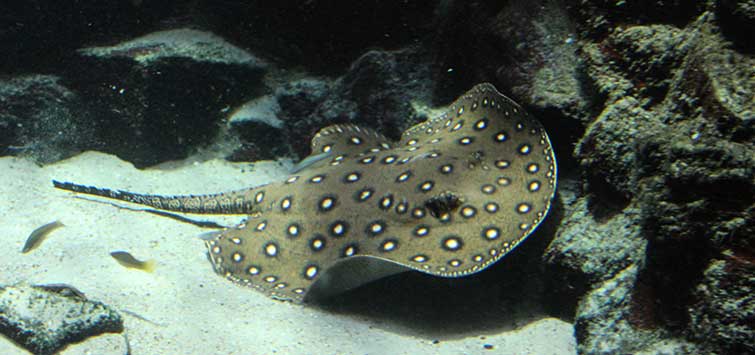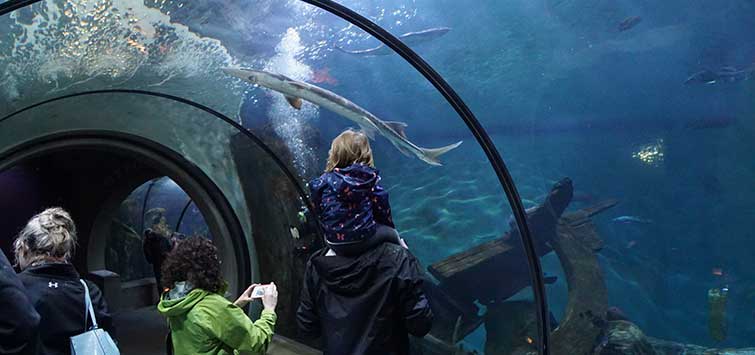A Visit to the Long Island Aquarium
Author: Mark Denaro
Take an armchair tour of the Long Island Aquarium and its extensive collection of species, impressive aquaculture facility, and exciting activities and tours.
The Breathtaking Long Island Aquarium
I recently had the opportunity to speak at a meeting of the Long Island Aquarium Society. Their meetings are held at the State University of New York at Stony Brook, which is fairly close to the eastern tip of Long Island. I’ve been wanting to visit the Long Island Aquarium for the last few years but hadn’t had the time to make the drive to Riverhead, New York on the eastern end of Long Island, so this was a great chance to combine the two activities and make a full day of it.
Formerly known as Atlantis Marine World, the Long Island Aquarium is definitely a destination that should be on your list of places to see. I enjoyed my visit so much that my local club, the Bucks County Aquarium Society, scheduled a group trip to the aquarium, where everyone enjoyed it as much as I did. The exhibits are far too numerous for me to mention all of them, so I’ll just tell you a bit about the ones I found most interesting.
An Extensive Aquaculture Facility
Upon arrival at the aquarium, I was met by aquarist Todd Gardner, who took me on a behind-the-scenes tour. I’ve been lucky enough to go behind the scenes at a number of aquariums in the United States, and the Long Island Aquarium is by far the most impressive. Every bit of available space is being used for something, and the aquaculture program that Gardner runs is extensive.
Some Fish Species
The aquarium is propagating numerous species of fish, including a variety of clownfish that will hopefully soon include their new arrival, Amphiprion chrysogaster. They’re also raising damsels, gobies, bamboo sharks, and several species of seahorses. Gardner has just succeeded at raising the world’s first Liopropoma basslets in captivity. The aquarium has breeding pairs of both the candy basslet(L. carmabi) and the Swiss Guard or peppermint basslet(L. rubre). Todd has been collecting the eggs of both species and had to wait until the young fish colored up to find out that the first ones he raised successfully were L. rubre.
The pelagic larval stage of these fish is extremely long lasting, 69 days (I was there on day 51) until the first fry settled to a bottom-oriented lifestyle. Complicating their rearing is a filament that extends from the dorsal fin and is many, many times the length of the body. This filament includes a number of fluid-filled bladders, and its function may be related to buoyancy, but determining that will require additional research. If the filaments become entangled, bad things happen, so it takes a lot of space to rear each larva. Todd has now raised L. carmabi and the extremely rare deepwater species, the bicolor basslet(L. klayi).
Invertebrates
The aquarium also raises a number of marine invertebrates, including berghia nudibranchs, several species of jellyfish, and a variety of shrimp, plus the flamboyant cuttlefish (Metasepia pfefferi), which the Long Island Aquarium has provided to numerous other aquariums and has now begun to supply in limited numbers to the pet trade. The largest invertebrate-propagation project involves the corals in the crown jewel of exhibits, the 20,000-gallon reef tank. The corals in this tank are clipped or fragged on a regular basis, and the frags are grown out in troughs with lots of light and water flow until they’re large enough to be transplanted or traded to another institution.
Other Specimens
Of particular interest to freshwater hobbyists, the aquarium is also raising motoro stingrays (Potamotrygon motoro).
Another interesting research program involves the chain catshark (Scyliorhinus retifer). This small species (for a shark) grows to a length of 2 feet and inhabits the continental shelf from Nova Scotia to Nicaragua, where it lives at depths of about 330 to 1,300 feet. It is a beautifully patterned species that would be a great addition to the hobby if only it could be kept at room temperature. Unfortunately for the home hobbyist, it requires very cold water.
Extensive Research
The Long Island Aquarium maintains a colony of over 100 of these fish for research. They are examining a number of issues, including feeding behavior, and have shown that sharks are not the voracious feeders that many people think they are. They’re also looking at a variety of issues relating to food assimilation and growth and how that is affected by sex, age, and water temperature.
Other aspects of this research involve reproduction and hormone levels and determining if all the eggs laid by a female are fertilized by a single male or if they are fertilized by multiple males. If they are fertilized by multiple males, is the fertilization random, or is there some factor that allows the sperm of one male to outcompete those of others to fertilize a disproportionate number of eggs? It’s very fascinating stuff and will significantly increase our knowledge of shark biology.
Coral Reef Tank and Surrounding Exhibits
After my behind-the-scenes tour, I spent the rest of the day exploring the exhibits from the public side. The 20,000-gallon reef is the most impressive display I’ve ever seen at any aquarium. It boasts an incredible array of corals, including both hard and soft corals and gorgonians. Many of the corals are several feet in height or diameter, and they’re built up in a way that really mimics a natural reef. In fact, the only thing that makes the observer realize they’re not looking at a slice of nature is the combination of animals from different oceans and seas.
The fish range in size from a couple of inches up to a few feet long in the case of the Napoleon wrasse (Cheilinus undulates), which is still growing. The population is extremely diverse and includes a number of flag basslets, numerous angels, damsels, clownfish, gobies, butterflies, wrasses, an unbelievable variety of tangs, and others. The fish are from the Atlantic, Pacific, and Indian Oceans, plus the Caribbean and Red Seas. This display was like a magnet for me and kept drawing me back, and I probably spent several hours watching it throughout the day.
The 2,000-Gallon Tanks
There is a row of 2,000-gallon aquariums across the main hall from the reef display. As one approaches them, the anemone and clownfish display really grabs the eye. It is brightly lit and filled with anemones along with lots of clownfish of a variety of species. Other fish include a group of Pacific blue tangs (Paracanthurus hepatus), two spectacular Moorish idols (Zanclus cornutus), a pair of saddleback butterflies (Chaetodon falcula), plus a few other tangs.
The next tank in the row is only dimly lit and replicates a shipwreck turned artificial reef, housing predatory fish such as groupers, lionfish, frogfish, and squirrelfish. To its left is a Lake Malawi biotope that houses mbunas and haps. The final display in this section is a local rocky-shore biotope that features growing kelp and other plants. Other aquariums in the main hall house seahorses and cuttlefish, all of which have been bred at the Long Island Aquarium.
Where Species Are Collected
Many of the Atlantic species on exhibit were collected around Long Island by Gardner and other staff members. These include species that live around Long Island year round and those that live in the tropical West Atlantic and whose eggs or larvae are carried north on the Gulf Stream. The tropical species cannot survive the winter in northern latitudes, so all the fish they collect have been saved from death due to cold temperatures.
Locally collected tropicals on display include blue angels (Holacanthus isabelita), several butterflies (Chaetodon capistratus, C. sedentarius, and C. striatus), blue tangs (Acanthurus coeruleus), doctorfish (A. chirurgus), various squirrelfish, the invasive lionfish (Pterois miles), and others. Year-round natives living at the aquarium include sand tiger sharks (Carcharias taurus) displayed in the Lost City of Atlantis Shark exhibit, Atlantic silversides (Menidia menidia) and Atlantic menhaden (Brevoortia tyrannus) in the Schooling Fish exhibit, flounders (Pleuronectes americanus) in the Flounder Find, and numerous other species.
Poseidon’s Treasure Room
An interesting area located upstairs is Poseidon’s Treasure Room, which features a number of smaller tanks of a similar size to those most of us have at home. A few that are of particular note include a tank of bamboo shark eggs, which are lit from behind so the observer can see the embryos moving inside the eggs; a very nicely planted tank housing Asian hillstream fish, including loaches along with rasboras, danios, and other cyprinids; and one of my favorite exhibits that is stocked with very colorful non-photosynthetic corals and other filter-feeding invertebrates along with a blue-striped dottyback (Pseudochromis springeri) and a juvenile banded butterfly (Chaetodon striatus) that was caught locally this year.
The Touch Tank
The Touch Tank is a treat for everyone, especially for the younger members of the family. There visitors can touch sea stars, clams, whelks, hermit crabs, horseshoe crabs, and other invertebrates. At Ray Bay, visitors can touch southern stingrays (Dasyatis americana) and cownose rays (Rhinoptera bonasus), and even participate in scheduled feedings. Kids of all ages will be delighted by the Butterfly Exhibit, where visitors can get up close and personal with a number of different butterflies, including blue morphos (Morpho menelaus), often referred to as the bluest thing on earth. From the Butterfly Exhibit, visitors walk through the Lorikeet Exhibit, where they can interact with these colorful, social birds. Bird lovers should also be sure to take in the Amazon Rainforest, which houses a number of parrots that are all rescued pets.
Outdoor Exhibits
Outdoor exhibits include river otters, penguins, seals, sea lions, and a water garden/koi pond. The Pirate Snorkel Adventure, an interactive experience in the 80,000-gallon snorkel tank, is a great opportunity to swim with the fishes and a particular favorite of kids, who should be good swimmers and bring a bathing suit. The interactive salt marsh allows visitors to see the typical brackish-water killifish habitat and get up close and personal with the spider crabs that inhabit this area.
I highly recommend a cruise on the Atlantis Explorer Tour Boat, which cruises down the Peconic River and into Flanders Bay, with educators promoting environmental awareness and education about the Peconic estuary. The boat stops at a small island where visitors can see the habitats of fiddler crabs, snails, hermit crabs, and numerous other species. Some of the younger kids will have a chance to run a seine around the island to catch various species of fish, shrimp, and other creatures. The learning continues on the boat as the educators discuss the fish that were caught, explain the life cycle of the local spider crabs, and play Fear Factor with lots of local invertebrates.
Numerous other interactive experiences are available, and you can find more information and plan your visit at the Aquarium’s website, www.longislandaquarium.com.
I definitely plan to visit the Long Island Aquarium again. If I lived closer, I’d volunteer and would be there on a regular basis, but the drive makes that unfeasible so I’ll have to settle for visiting. If you have the opportunity to visit, you should definitely take advantage of it. Maybe I’ll see you there!
See the full article on TFH Digital http://www.tfhdigital.com/tfh/201302#pg99

.png?h=595&iar=0&w=2781&hash=5FD5E69473BCC22199FBFA2FB71B6033)



